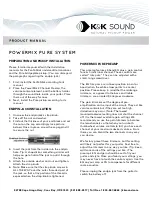
Series 8650B Universal Power Meters
2-26
Publication 31470-001, Rev C, November 2, 2017
2.4.3.4
Low Level Performance Check
This procedure provides a quick-check list for evaluating meter/sensor performance for low-level
measurements. It is not intended to verify performance of specifications such as Noise, Temperature Coefficient
and Zero Set. For complete verification, please refer to Chapter 4.
1.
This test is meant to check the low level performance of the meter and sensor. In order to do so, the meter
and sensor should first be separated from any external amplifiers, test systems, etc. Turn the meter on and
allow stabilization at ambient for a minimum of 30 minutes. Connect the sensor cable to the meter and the
sensor to the calibrator output port.
2.
Calibration.
Calibrate the power meter by pressing the
[CAL/ZERO]
button.
NOTE:
During calibration an approximate zero is established for calibration purposes only. This zero is
not valid for actual measurements and can limit the measurement range as high as –50 dBm. For
proper low-level measurements, the sensor must be zeroed at the test port of the system being
tested. Zeroing at the test port provides corrections for ground line voltages and connector interface
EMF.
3.
Zeroing.
Validation of meter and sensor noise floor will be checked using an attenuator or termination.
Connect the attenuator or termination to the sensor and allow the unit to stabilize for 3 minutes. The
sensor must be thermally stabilized for proper zeroing. If the thermal condition of the sensor varies during
the zero procedure, the zero will not be valid.
4.
Set averaging to 1024 and configure for CW operation. After the unit has thermally stabilized, push the
[CAL/ZERO]
button.
5.
Immediately after zeroing, confirm that the meter reading is at least 3 dB below the minimum CW
operating range of the sensor. This checks the noise floor and zero set capabilities of the meter and sensor.
6.
Zero Drift.
Zero Drift is a measure of the change in noise over time. Each family sensor will have a specified
expectation of drift over a one-hour period. To confirm, set the meter to linear display (Watts) after
verifying noise floor and check that the display does not drift beyond specification over a one-hour period.
Verification for specifications such as noise, zero drift and temperature coefficient of linearity are difficult, time
consuming tests. This checklist is useful to quickly determine if there is a catastrophic system failure. Failure to
meet the above guidelines is not necessarily an indication of specification failure. Final confirmation of system
specification performance is achieved using the verification procedures found in Chapter 4.
Содержание 8650B Series
Страница 3: ...Series 8650B Universal Power Meters Publication 31470 001 Rev C November 2 2017 iii ...
Страница 18: ......
Страница 32: ......
Страница 78: ......
Страница 236: ......
Страница 244: ......
Страница 258: ......
Страница 263: ...Menu Structure Publication 31470 001 Rev C November 2 2017 D 3 Figure D 3 Modulation Sensor B Setup Menu Structure ...
Страница 265: ...Menu Stucture Publication 31470 001 Rev C November 2 2017 Page D 5 Figure D 4 Meter Setup Menu Structure ...
Страница 267: ...Publication 31470 001 Rev C November 2 2017 Last page of the document ...
















































